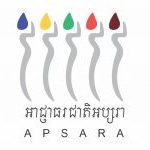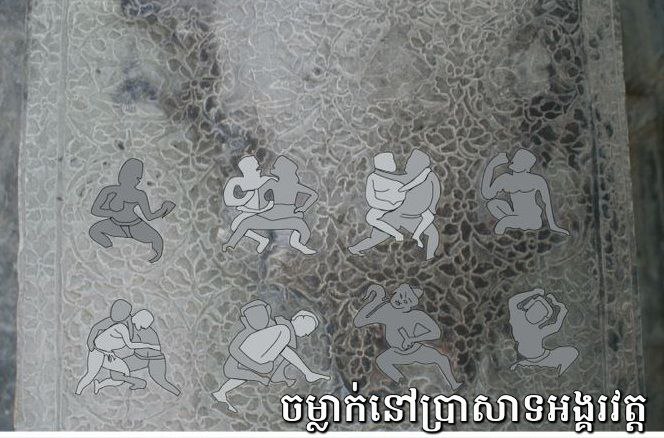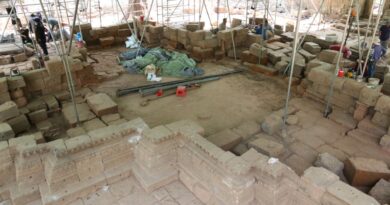លោក ភឹង តារា បុរាណវិទូអាជ្ញាធរជាតិអប្សរា បានបង្ហាញនូវរូបចម្លាក់មួយចំនួនទាក់ទងនឹងក្បាច់វាយគ្នា ដូចជាគុនខ្មែរ ចំបាប់ ឬល្បុកតោ នៅតាមខឿននៃប្រាសាទមួយចំនួនក្នុងតំបន់រមណីយដ្ឋានអង្គរ។ តាមអ្នកជំនាញ រូបចម្លាក់ទាំងនោះមាននៅប្រាសាទតាព្រហ្ម បាយ័ន អង្គរវត្ត បន្ទាយសំរែ ព្រះខ័ន និងប្រាសាទប្រីជាដើម។
លោក ភឹង តារា ពន្យល់ថា ភាគច្រើនចម្លាក់គុន ឬក្បាច់វាយគ្នាទាំងនោះ ច្រើនឆ្លាក់ជាចម្លាក់តូចៗ មានឆ្លាក់នៅខឿនខាងផ្នែកខាងក្រោមប្រាសាទ។ តួយ៉ាងនាខឿនខាងត្បូងសាលរបាំ នៃប្រាសាទតាព្រហ្ម ចម្លាក់ប្រមាណ៨រូប បានឆ្លាក់តម្រៀបគ្នាជាជួរ ដោយមានជាក្បាច់ឱបក ឡើងជង្គង់ កម្ដៅសាច់ដុំ ការឱ្យទឹក។ល។ ក្រៅពីនោះ មានឆ្លាក់ដាច់ពីគេនៅផ្នែកខាងត្បូងនៃប្រាសាទនេះផងដែរ។
នៅប្រាសាទតាព្រហ្មដដែល ត្រង់ចម្លាក់ដែលមានមនុស្សពីរនាក់ឡើងជង្គង់។ រូបនេះ ត្រូវបានលោក ភឹង តារា យល់ថាជាគុនខ្មែរ ដោយគេឃើញមានមនុស្សពីរនាក់ កំពុងប្រកួតគ្នា។ អ្នកនៅខាងស្តាំចាប់ក្បាលអ្នកនៅខាងឆ្វេងសង្កត់ចុះក្រោម ឯជើងខាងឆ្វេងវិញឡើងជង្គង់ទៅរកគូប្រកួតខ្លួន។ តែអ្នកនៅខាងឆ្វេងវិញ យកដៃស្តាំរបស់ខ្លួនចាប់ទប់ជង្គង់នោះ កុំឲ្យមកត្រូវមុខបាន។ អ្នកស្រាវជ្រាវ យល់ថា នេះប្រហែលជាការប្រកួតនៅក្នុងការហាត់សមប៉ុណ្ណោះ ដ្បិតអីនៅប៉ែកខាងស្តាំនៃរូប ឃើញមានមនុស្សម្នាក់អង្គុយបញ្ឈរជង្គង់ យកដៃចង្អុលមកអ្នកទាំងពីរ ហាក់ដូចជាបង្គាប់ស្នៀតអ្វីមួយ។
ចំណែកចម្លាក់នៅជញ្ជាំងប្រាសាទព្រះខ័នវិញ លោក ភឹង តារា ពន្យល់ថា គេឃើញនៅ លើសសរផ្អោប ឃើញមានមនុស្សពីរនាក់ចាប់ឱបកាច់គ្នា ដោយអ្នកខាងឆ្វេងចាប់កាច់ កគូប្រកួតមកក្រោម តែអ្នកស្តាំនោះវិញក៏ខំឱបចាប់ភ្លៅដៃគូខ្លួនជាប់ ដើម្បីកុំឲ្យកាច់ផ្តួលខ្លួនបាន។
ដោយសារជាចម្លាក់ល្អិត ដូច្នេះចម្លាក់ទាំងនោះ ពុំសូវមានអ្នកស្គាល់ និងចាប់អារម្មណ៍ទេ។ ពួកគេតែងទៅ និងមកហួសជានិច្ច៕
អត្ថបទ៖ នាង សំណាង
រូបភាព៖ ភឹង តារា, ភោគ ជា
Mr. Phoeung Dara, an archaeologist from the APSARA National Authority, points out some bas-relief sculptures related to Kun Khmer such as Khmer martial arts, wrestling, or labokator on the platform of some temples in the Angkor site. According to this expert, these bas-relief sculptures are found at Ta Prohm, Bayon, Angkor Wat, Banteay Samre, Preah Khan, and Prei temples, etc.
Mr. Phoeung Dara explains that most of the Khmer martial arts are carved into small sculptures on the lower part of the temple. For example, on the southern platform of Ta Prohm’s Dance Hall, about eight sculptures are carved in a row, with hugs, kneeling, warming muscles, watering, etc. Apart from that, there are also isolated carvings on the south side of the temple.
At Ta Prohm temple, there is a sculpture where two people use knee kicks. Mr. Phoeung Dara considers this sculpture to be a Khmer martial artist, as two people were seen competing. The one on the right grabs the head of the one on the left presses down, and the left foot rests on his knees toward his opponent. But the one on the left uses his right hand to hold the knee so that it does not come face to face. Researchers believe that this may be just a rehearsal for the game, because, on the right side of the sculpture, a person is sitting on his knees, pointing to the two of them, as if ordering something.
As for the bas-relief sculptures on the wall of Preah Khan temple, Mr. Phoeung Dara explained that on the pillar, two people were seen hugging each other, with the left person grabbing the opponent’s neck and the right person trying to hug his partner’s thigh and hold on.
Because these bas-relief sculptures are so small, they are not well known. They always go back and forth. Mr. Dara wants the sculptures to be widely publicized because they are important heritage and historical documents for future generations.
Article: Neang Samnang
Photos: Phoeung Dara, Phouk Chea





